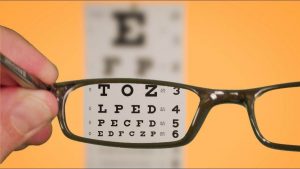Improve Your Eye Sight
Every year, on the last Shabbat before Elul—the final month of the year, we read a Torah portion that begins with the word reeh—see. The passage reads, “See, I set before you a blessing and a curse. The blessing is that you fulfill the commandments of G-d your G-d that I command you today. The curse is if you don’t fulfill the commandments . . .” (Deuteronomy 11:26–28).
The word “see” stands out as superfluous. The message can be easily transmitted without the preface, “see.” In fact, it is hard to see (no pun intended) how “see” adds to the message. Moreover, these blessings and curses refer to the covenant that G-d struck with our ancestors on the plains of Moab, where the priests chanted blessings and curses before the nation. (Rashi ad loc.) It turns out they didn’t “see” these blessings and curses; they heard them. So, why does the Torah tell us to “see” them?
The Organ of the Month
There is a fascinating teaching in Jewish mysticism that attaches a bodily organ to each month of the Jewish calendar year (Rabbi Chaim Vital, Taamei Hamitzvot, Parshat Bo). The events that occurred in our history during this month either strengthened or weakened that organ. The current month (Av) and the preceding month (Tamuz) are associated with our two eyes—one eye for Tamuz and one eye for Shevat.
What were perhaps the greatest tragedies in our history, the dual destruction of the First and the Second Temples in Jerusalem, occurred during these months. (A) The walls around Jerusalem were breached in the month of Tamuz, clearing the way for the enemy to assault and destroy the largest Jewish community in Israel, and to approach the Temple Mount. (B) The Temple was destroyed in the month of Av.
Concealed Love
If ever there was a time when G-d’s love was concealed, this was it. The streets of Jerusalem ran red with Jewish blood. The heart and soul of Judaism went up in flames with the Temple. The holiest, wisest, and greatest of our people were slaughtered. Hope for the future was all but lost—kept alive by a handful of Jews who, each in their own way, helped the nation survive.
This was a time of open Heavenly wrath, yet there was one man who saw things differently. Asaf the priest (Psalms 79) publicly thanked G-d for expending His wrath on structures of wood and stone while preserving His people. The eyes of most people were blind to this perspective, but one Jewish leader had the eyes to “see” it. Indeed, Jewish leaders are described as the nation’s eyes (Numbers 15:24).
Similarly, our sages (Yoma 54b) tell us that when the Marauders broke into the Holy of Holies, they found the Cherubs facing and reaching for each other. These Cherubs were made of gold, but their positions shifted miraculously. When Jews and G-d enjoyed mutual goodwill, the Cherubs faced each other. When Jews turned from G-d and were punished by G-d, the Cherubs turned from each other.
You would expect the Cherubs to have turned from each other when the Marauders broke into the Holy of Holies. Yet, the Cherubs were facing each other in a tight embrace. It indicated that G-d and the Jewish people were in a state of deep love. But that was a secret concealed within the walls of the Holy of Holies. The scene unfolding outside seemed vengeful and wrathful.
We now understand why Jewish mystics said that our eyes were affected by the events of these two months. The Temple, a place devoted to showcasing our love for G-d and G-d’s love for us, became a symbol of Divine wrath. We were no longer able to “see” His love. Yet, with the guidance of our mentors and leaders, we could flip the script and learn to “see” the love hidden in the wrath.
Our task during these two months is to repair the damage to our eyesight. We are not accustomed to seeing the silver lining in all things. Life teaches us pessimism; our task is to convert it to optimism. Life teaches us to dwell on adverse events; our task is to learn to dwell on the positive. Of the entire year, these two months are most conducive to improving our perspective and spiritual eyesight.
We can now see why the Torah portion that we read on the last Shabbat of these two months, the day this effort reaches its climax, begins with the word “see.” It instructs and empowers us to restore our eyesight and “see” our blessings and curses. We are accustomed to judging events based on their surface appearance. The Torah empowers us to “see” things differently. To look deeper before determining if something is a blessing or a curse.
A Blind Man with X-Ray Vision
The Talmud (Taanit 21a) tells us about a man named Nachum Ish Gam Zu—the man who always said, “This too [is for the good].” Nachum was blind, but he always insisted that everything was for the best. When our sages said he was blind, they were referring not only to physical sight but also to spiritual sight. He lived after the Temple’s destruction, a time when G-d’s love for us was not visible. The Jewish people, their leaders included, were blind to G-d’s love.
But as a mentor and leader, he taught the Jews to believe in the silver lining even if they couldn’t “see” it, even if they were metaphorically blind to it. On one occasion, he travelled to Rome with a chest of gems as a tribute to the emperor. On the way, thieves stole the gems and replaced them with sand. This seemed like a terrible turn of events, but Nachum proclaimed that this, too, was for the good and travelled on.
He arrived in Rome and presented his tribute. As expected, the emperor flew into a rage against the insolent Jews who dared mock him with a gift of sand. Suddenly, a royal advisor (the Talmud says it was Elijah descended from Heaven) suggested that this might be the special sand with which Abraham defeated his enemies. (Abraham once fought an overwhelming enemy force, and he pelted the enemy with sand. The sand turned into arrows, and Abraham won the war.) The emperor had it tested in one of his military campaigns, and the sand worked just as advertised.
Nachum could not have foreseen how the theft of his gems could have been a good thing. He was blind to the secret. But he believed it was good and continued his journey. Because he believed it, he merited seeing the miracle. That is the message to us. We must learn to believe that everything that happens to us is for the good. When we do, we will merit to “see” it too. The world says, “We will believe it when we see it.” Judaism says, “We will see it when we believe it.”
Month of Repentance
The last month of the year—Elul—is a time to take stock of our actions throughout the year and repent for our shortcomings. It is only fitting that we dedicate some of our energy this month to correcting our shortsightedness. To bolster our faith in G-d’s goodness so we can merit seeing it.
This leads me to a final thought. The Torah’s words are, “The blessing is that you will observe the commandments.” Rashi explained that the blessings are conditioned on our observance.
In Jewish law, when we stipulate a payment on the fulfilment of a condition, if the condition is met, the payment is backdated to the day the condition was set (Kidushin 60b). This tells us that if we learn how to “see” G-d’s love even in prosaic things, G-d will backdate our blessings to this Shabbat. This way, the new year will arrive with its blessings already intact.[1]
[1] This essay is based on Rabbi Chaim Eliezer Shapiro of Munkatch, Chaim Veshalom, on our parshah.


























